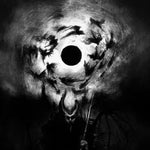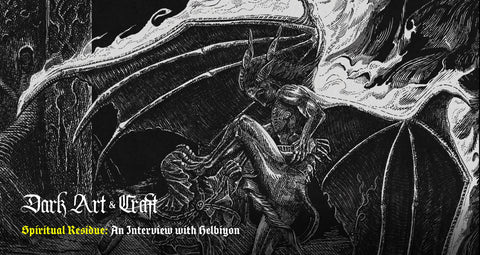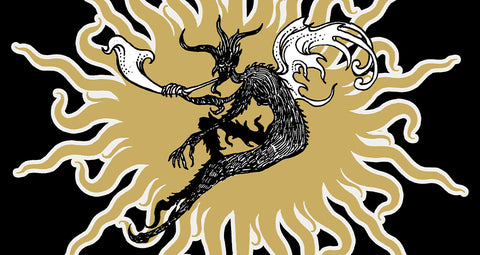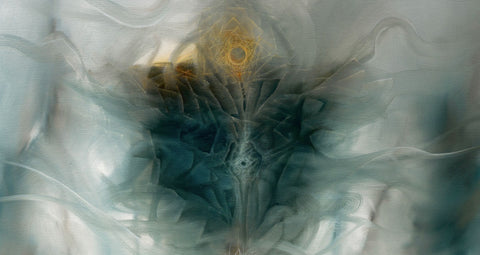
Unio Mystica by Johfra Bosschart. Image via Reddit - Visual melt
Occult Symbolism in Dark Art
The general use of Art and symbol in cult and magic rituals has been employed since at least the Neolithic era and was used throughout ancient cultures. These early representations have evolved into a rich Artistic tradition with symbol and markings as diverse as the the sigils of Occultist Austin Osman Spare and symbology of modern avant-garde filmmaker Alejandro Jodorowsky.
The breath of dark symbolic Art is vast and we have only chosen a few areas where symbol has directly intertwined with the Dark Artists we admire. The Occult or Hidden arts require a natural fascination.. an interest in the Dark part of our nature we so often overlook.
Occult Symbol
Including magic, astrology, Kabbalah, Tantra, esoteric practices, mystical and witchcraft - occultism contains a beautiful array of symbolism. Hidden or esoteric symbols are a vast collection of sources from tarot, zodiac, talismans, book illustrations, fine Artworks and beyond. We've compiled a few of the books and resources we've comes across but the depth of symbology is staggering in itself so please take our recommendations as personal (or maybe even nostalgic).
Art and Symbols of the Occult: Images of Power and Wisdom by James Wasserman 1993 a visual collection of occult imagery that pulls from Alchemy, Astrology, Tarot and visionary Art. Image via Amazon.com. Wasserman has been active in publishing Aleister Crowley's corpus of work and is a member of the Ordo Templi Orientis. Ordo Templi Orientis (O.T.O.) is a religious and fraternal organization that was founded in the early 20th century. It was established as a modern revival of the Order of the Temple of the East, or the Templars, a medieval knightly order. The organization was founded by Carl Kellner and Theodor Reuss, and was later led by Aleister Crowley, who is considered one of the most influential figures in the history of O.T.O. O.T.O. is based on the principles of Thelema, a philosophical and spiritual system developed by Crowley. "Do what thou wilt shall be the whole of the Law." The organization's teachings and practices center around the attainment of personal enlightenment and the attainment of the highest level of spiritual awareness.

Hidden symbolism of alchemy and the occult arts H. SILBERER 1971 image via amazon. While light on actual images this volume is a trove of knowledge in written form.
The Art of the Occult: A Visual Sourcebook for the Modern Mystic by S. Elizabeth a feast of Artwork inspired by the spiritual, mystical and magic. Image via Amazon.com.

Southern Mesopotamian "Demon Bowl" with incantation c. 200-600 AD. The bowl was used as an early form of protective Magic from dark entities. Exhibit in the Royal Ontario Museum, Toronto, Ontario, Canada. Image via wikipedia. You can notice the early circular spell incantation or "Magic Circle". A Magic Circle is formed to create a sacred space or in the Demon bowl's case a cunning trap, in even earlier history the Sumerians called this practice Zisurrû, meaning “magic circle drawn with flour" used to ensnare evil forces.
Witchcraft
In the context of art, witchcraft has often been depicted through the use of symbolic imagery and motifs. Some common symbols and motifs associated with witchcraft include pentagrams, cauldrons, magic wands, and broomsticks. These symbols are often used to represent the power and influence of the witch, as well as the tools and objects used in their practices.
In addition to these symbols, witchcraft has also been depicted in art through the use of specific motifs and themes. For example, many works of art that depict witchcraft feature themes of nature, such as plants and animals, which are believed to be connected to the spiritual world. Other common themes include the moon, which is often associated with feminine energy and the divine feminine, and the sun, which is often associated with masculine energy and the divine masculine.
Modern Adaptions
Another Artist bringing Occult symbology into the visual Arts was Johfra Bosschart. Born in 1919 in Rotterdam as Franciscus Johannes Gijsbertus van den Berg or better known just as Johfra the Dutch Surrealist described his own work as “Surrealism based on studies of psychology, religion, the Bible, astrology, antiquity, magic, witchcraft, mythology and occultism”. The Artist's Zodiac series of paintings and later works are a mixture of a unique organic surrealism and and epic occult symbolism.

Unio Mystica by Johfra Bosschart. Image via Reddit - Visual melt also features some additional works and information on Johfra. A video documentary on Johfra and his Art.

Aquarius - Image via https://greatarcana.com/johfra-bosschart-the-zodiac-series/

Witches' Sabbath, Johfra Bosschart Image via https://en.wikipedia.org/wiki/Art
A film image from Alejandro Jodorowsky's The Holy Mountain. image via https://devilinthedetailssite.wordpress.com/2019/12/18/the-occult-influence-of-alejandro-jodorowsky/
Alejandro Jodorowsky (1929 - ) the avant-garde filmmaker and creator of The Holy Mountain portrayed occult symbology, magick and Tarot in his movies frequently. The Occult Influence of Alejandro Jodorowsky describes the various visual references made in Jodorowsky's cinematic productions which are often steeped in religious symbols and Occult imagery.
Jodorowsky's films have had a major influence on the surrealist and avant-garde movements, and he is considered a pioneer of the midnight movie genre. Some of his most famous films include "El Topo" (1970), "The Holy Mountain" (1973), and "Santa Sangre" (1989). In addition to his work in film, Jodorowsky has also been a successful author, publishing numerous books on spiritual, occult and philosophical subjects.
Sacred Geometry
Sacred Geometry imparts spiritual meaning to geometric shapes and physical spaces. Used extensively in designing religious structures, ritual sites, altars, templates and even tree groves, sacred geometry is a blueprint for many of these spaces.

Ālī Qāpū Palace and Music Hall, Isfahan. the Ālī Qāpū Palacehas an incredible music hall that hosts several concerts a year. The beautiful acoustics produced in the structure gives the effect of an entire orchestra. Image via inhabiatat.com
In Islamic Art the use of geometric designs is built from circles and squares often in complex overlapping patterns. These geometric patterns are used in the construction of mosques and the written Art of calligraphy. In western Art, the astronomical work, Mysterium Cosmographicum or Cosmic Mystery, The Secret of the World (1597) Johannes Kepler believed he had reveled the geometrical plan for the universe. A reflection of god with the Sun as the center the universe; a Heliocentric world which Kepler detailed and formulated with his laws of planetary motion. Kepler experimented with 3-dimension polyhedra and spherical orbs that corresponded to the paths of planets and the Sun.

Altar structures used for sacrifice in various religious and ritual practices often incorporate symbolic shapes and imagery. In Norse paganism the Altar place or wood and stone monument was called Hörgr in which animal sacrifice would be presented to deities.
The famous Sagrada Familia in Spain is created on the Magic Constant of 33 the sum of every row, column and line in the massive structure by Gaudi. Gaudi sought to link geometry, shape and nature in a cohesive unity.

Inside the Sagrada Familia in Barcelona looking up at the column structure based on the number 33 - Image via https://www.needpix.com/photo/1728700/
Sigils
A Sigil is a symbol used in ritual magic as signature or mark of an entity. In past medieval magic practices the Sigil was used to represent a specific Angel or Demon.The Ars Goetia, a book within the Lesser Key of Solomon an anonymous grimoire on Demons from the 17th century contains a list of Seventy-Two Sigil markings directly tied to demonic entities.

Four Goetic seals from the Lesser Key of Solomon, Image via wikipedia
Artist and Occultist Austin Osman Spare created a modern approach to Sigils considered to be a fundamental part of Chaos Magick which was developing in England during the 1970s. The sigils used in these practices represent a (psychological) desire or intention rather than a specific supernatural entity. Spare was known for his unique style of drawing, which incorporated elements of surrealism and automatism. His art often featured complex symbols and allegorical imagery that were meant to evoke powerful spiritual and psychological states.

The Seventy-Two Goetia Sigils from The Book of the Goetia of Solomon the King by S.L. MacGregor Mathers and Aleister Crowley. This file is licensed under the Creative Commons Attribution-Share Alike 4.0 International license.

Sigils of Austin Osman Spare - Image via https://visualmelt.com/Austin-Osman-Spare

Austin Osman Spare sigils illustrated

Symbol & Art Resources
The Occult Influence of Alejandro Jodorowsky
Instances of Sacred Geometry in Famous Buildings Around The World
Atlas Obscura Sagrada Família in Barcelona, Spain
Art and Travel Notebooks: Sacred Geometry, Crypts and Moon Symbols
Johannes Kepler: The Mysterious Music of the Spheres
Kaleidoscopic photos of Iranian mosques capture their gorgeous geometry







